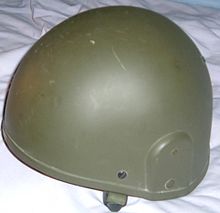- Combat helmet
-
A combat helmet or battle helmet is a type of personal armor designed specifically to protect the head during combat. Helmets are among the oldest forms of personal protective equipment and are known to have been worn by the Akkadians/Sumerians in the 23rd century BC, Mycenaean Greeks since 17th century BC,[1][2] the Assyrians around 900 BC, ancient Greeks and Romans, throughout the Middle Ages, and up to the end of the 17th century by many combatants.[3] Their materials and construction became more advanced as weapons became more and more powerful. Initially constructed from leather and brass, and then bronze and iron during the Bronze and Iron Ages, they soon came to be made entirely from forged steel in many societies after about 950AD.
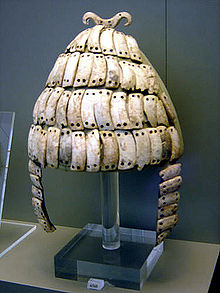 Mycenaean Greek boar tusk helmet, Mycenae, 14 century BCE
Mycenaean Greek boar tusk helmet, Mycenae, 14 century BCE
At that time, they were purely military equipment, protecting the head from cutting blows with swords, flying arrows, and low-velocity musketry.
Military use of helmets declined after 1670, and rifled firearms ended their use by foot soldiers after 1700.[3] By the 18th century, cavalry units often wore steel body cuirasses, and frequently metal skull protectors under their hats, called "secrets". The Prussian leather spiked helmet, or Pickelhaube, offered almost no protection from the increased use of artillery during World War I, and in 1916 was replaced by the German steel helmet, or Stahlhelm, and afterwards was worn merely for tradition.[4][5][6]
The Napoleonic era saw ornate cavalry helmets reintroduced for cuirassiers and dragoons in some armies; they continued to be used by French forces during World War I as late as 1915, when they were replaced by the new French Adrian helmet.[7] The French Adrian helmet was the first modern steel helmet[8][9] and was soon followed by the adoption of similar steel helmets by the other warring nations.
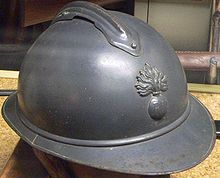 The French infantry M15 Adrian helmet was the first modern steel helmet.
The French infantry M15 Adrian helmet was the first modern steel helmet.
 US Marine Corps M1917 Brodie helmet.
US Marine Corps M1917 Brodie helmet.
World War I and its increased use of artillery had renewed the need for steel helmets, which were quickly introduced by all the combatant nations for their foot soldiers. In the 20th century, such helmets offered protection for the head from shrapnel and fragments.[10]
Today's militaries often use high-quality helmets made of ballistic materials such as Kevlar and Aramid, which offer improved protection. Some helmets also have good non-ballistic protective qualities, though many do not.[11] Non-ballistic injuries may be caused by many things, such as concussive shock waves from explosions, physical attacks, motor vehicle accidents, or falls.[12]
Contents
History
Current
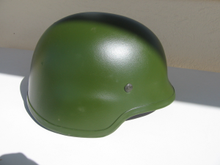 A modern German Army Gefechtshelm
A modern German Army Gefechtshelm
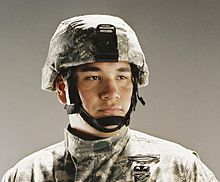 United States soldier wearing the Advanced Combat Helmet.
United States soldier wearing the Advanced Combat Helmet.
Model Origins Users SPECTRA helmet  France
Franceused by the French Army, Danish Army, United Nations peacekeeping forces[13] Modular Integrated Communications Helmet  United States
United Statesdeveloped for special operations use by the United States Army, it became the basis for the Advanced Combat Helmet which is now the standard issue helmet of the US Army.(ACH)[14][15][16] Lightweight Helmet  United States
United Statesused by United States Marine Corps[17] Mk. 6 Helmet  United Kingdom
United Kingdomused by British Armed Forces (all arms)[18]. being replaced by the Mk. 7 Helmet Mk. 7 Helmet  United Kingdom
United Kingdomused by British Armed forces BK-6 Helmet  Croatia
Croatiaused by the Croatian Army, Czech Army, Bulgarian Army, United Arab Emirates Army, Lithuanian Armed Forces, Mexican Army, Spanish Army, Turkish Army, Pakistan Army, Malaysian Army, Saudi Arabian Army, Finnish Army, National Army of Colombia, Armed Forces of the Republic of Kazakhstan, Italian Army, Military of Hungary, Armed Forces of the Argentine Republic and by the police forces of the following countries: Croatia, UK, Spain, Republic of Macedonia, Egypt, Russia, Saudi Arabia, Colombia, Italy, Ukraine and by Argentina and by the UN demining committee.[19] CCB (Combat Ballistic Helmet)  Brazil
BrazilUsed by the Brazilian Armed Forces in two versions: Polymer and Kevlar.[20] Enhanced Combat Helmet  Australia
Australiaintroduced into Australian service in 2004, replacing the PASGT. CG634  Canada
CanadaUsed by the Canadian Forces since 1998.[21][22] PASGT  United States
United StatesUsed by the USAF, but is being phased out by the ACH[23] US Air Force.[24] GOLFO  Chile
ChileMilitary of Chile, Similar to the PASGT. QGF03  People's Republic of China
People's Republic of ChinaPeople's Liberation Army QGF02  People's Republic of China
People's Republic of ChinaPeople's Liberation Army SSh68  Russia
RussiaSteel helmet Russian Army[disambiguation needed  ] Russia
] Russia6B7-1L  Russia
RussiaKevlar helmet Russian army[disambiguation needed  ] and Naval Infantry Russia
] and Naval Infantry RussiaSTSh-81  Russia
RussiaTitanium helmet Russian Special Forces Russia Kolpak 2  Russia
RussiaKevlar helmet Russian army[disambiguation needed  ]
]6B27  Russia
RussiaKevlar helmet Russian army[disambiguation needed  ]
]6B28  Russia
RussiaKevlar helmet Russian army[disambiguation needed  ]
]6B26  Russia
RussiaKevlar helmet Russian army[disambiguation needed  ]
]6B7  Russia
RussiaKevlar helmet Russian army[disambiguation needed  ]
]OR-201  Israel
IsraelKevlar helmet used by the Israel Defense Forces, Some units of Special forces of Indian Army, Lebanon (Lebanese Forces, South Lebanon Army, Hezbollah, Lebanese Army), Honduran Army, Guatemalan Army, Peruvian Army, Romanian Army, Nicaragua (National Guard and Police), Portugal (Portuguese Marine Corps), Irish Defence Force, South African Defence Force, Sri Lanka (Army and Police), and other countries. KASDA  Israel
IsraelKevlar helmet Israel Defense Forces, Guatemalan Army Gefechtshelm Schuberth B826  Germany
Germanyused by the Bundeswehr, Swiss Army, Dutch Army, Estonian Defence Forces, Czech Army and other countries - PASGT type helmet MARTE  Spain
SpainProtec type helmet replacing PASGT type helmets Sistema Compositi SEPT-2 PLUS  Italy
Italyused by the Italian Armed Forces[25] Sistema Compositi SUPERUBOTT  Italy
Italyused by Special Units (particularly GIS) of the Italian Law Enforcement community[26] Tecnoplast TD-71  Italy
Italyused by the Italian Law Enforcement community for riot control[27] Type 88 Helmet  Japan
Japanused by the JSDF - PASGT type helmet Type 66 Helmet  Japan
JapanVariant of M1 Helmet used by some elements of the JSDF Ground Forces M80 Helmet  Iraq
IraqPlastic and cloth helmet, limited use M87  South Africa
South AfricaKevlar helmet South African Army Hjälm 90  Sweden
Swedenused by the Swedish Armed Forces Composite Helmet K96  Finland
Finlandused by the Finnish Defence Forces RBH303IE  Ireland
IrelandUsed by the Irish Defence Force Mile Dragić M-97  Serbia
SerbiaUsed by the Serbian Army - PASGT type helmet[28] Mile Dragić M-05  Serbia
SerbiaUsed by Serbian Special Forces—MICH type helmet[29] World War I–Vietnam
Model Origins Users Adrian helmet  France
France[7] used in  France,
France,  Belgium,
Belgium,  Japan,
Japan,  Serbia,
Serbia,  Yugoslavia,
Yugoslavia,  United States,
United States,  Soviet Union, Irish Free State,
Soviet Union, Irish Free State,  Italy,
Italy,  China,
China,  Manchukuo,
Manchukuo,  Romania
RomaniaBrodie helmet  United Kingdom
United Kingdomused in  United Kingdom,
United Kingdom,  Canada,
Canada,  United States,
United States,  Australia,[10]
Australia,[10]  China,
China,  Estonia,
Estonia,  Belgium
BelgiumMk III Turtle helmet  Canada,
Canada,  United Kingdom
United KingdomM33 helmet  Italy
Italy Italy,
Italy,  Finland
FinlandBulgarian M36 Helmet  Bulgaria
BulgariaBulgaria[30] M1 Helmet  United States
United StatesU.S.Army, U.S.Marine Corps;  Canada,[31]
Canada,[31]  China, Guatemalan, Philippines,
China, Guatemalan, Philippines,  Belgium
BelgiumPickelhaube  German Empire
German Empire German Empire
German EmpireSoviet helmets during World War II  Soviet Union
Soviet Union Soviet Union,
Soviet Union,  People's Republic of China,
People's Republic of China,  North Korea,
North Korea,  North Vietnam,
North Vietnam,  Finland, Warsaw Pact
Finland, Warsaw PactStahlhelm[4][5][6]  German Empire
German Empire Chile,
Chile,  China,
China,  Irish Free State,
Irish Free State,  Nazi Germany,
Nazi Germany,  Poland,
Poland,  Weimar Republic,
Weimar Republic,  Estonia,
Estonia,  Finland
FinlandHełm wz. 31  Poland
PolandPoland Medieval and early modern militaries
Model Origin Users Bascinet circa 1300 Europeans during the Hundred Years' War(1337 to 1453) amid the kingdoms of  France,
France,  Aquitaine,
Aquitaine,  Burgundy and
Burgundy and  England
EnglandBurgonet[32] circa 1600 Europeans, especially by militias of  Poland &
Poland &  Switzerland
SwitzerlandCapeline late 16th century Europeans during 17th century, including the English Civil War in  England & Thirty Years' War across the
England & Thirty Years' War across the  Holy Roman Empire
Holy Roman EmpireCervelliere late 13th century Christian Europeans in Crusades during the 14th century Great helm[33] 1189 Christian Europeans in Third Crusade; other Europeans until 1540 Kabuto circa 1600 Samurai especially during the 17th century of the Edo Period Tokugawa shogunate in Medieval  Japan.
Japan.Morion 16th and early 17th centuries Spanish (esp. associated with Conquistadores), Swiss and English Pickelhaube[4][5][6] 1842 especially by  Prussia &
Prussia &  German Empire and other Europeans until 1918; revived for 2006 FIFA World Cup in
German Empire and other Europeans until 1918; revived for 2006 FIFA World Cup in  Germany
GermanyRaupenhelm circa 1800-1870 High crested leather helmet used primarily by  Kingdom of Bavaria and
Kingdom of Bavaria and  Württemberg
WürttembergSallet circa 1450 used in Northern Europe &  Hungary until mid-16th century
Hungary until mid-16th centurySpangenhelm[34] 5th century Central Asia, Near East & Europe; espec. by Scythians, Sarmatians, Persians, & Germans until 1000 Tarleton circa 1770-1800 Crested, peaked leather helmet used by cavalry and light infantry by  Great Britain,
Great Britain,  France and
France and  USA in the late 18th and early 19th centuries.
USA in the late 18th and early 19th centuries.Qing parade helmet after 1655 till 1911 China See also headgear listing within Components of medieval armour.
Ancient militaries
Model Origin Users Attic helmet ancient Greeks Boar's tusk helmet 17th century B.C.E. Mycenaean Greeks until 10th century BCE Boeotian helmet ancient Greek cavalry Chalcidian helmet ancient Greeks Corinthian helmet[35] ancient Greeks Disc and stud helmet circa 400 BCE ancient Illyrians & Adriatic Veneti until 167 BCE Galea (helmet) ancient Romans Horned helmet circa 1000 BCE Celtic Europeans until 700 CE Illyrian type helmet ancient Greeks Kegelhelm ancient Greeks Negau helmet ancient Etruscans in Negau, Slovenia Montefortino helmet ancient Romans Pilos ancient Greeks Pot helmet ancient Illyrians Phrygian/Thracian helmet 400s BCE ancient Greeks in Thrace, Dacia, Italia & Hellenistic Europe until circa 200 CE Design
Padding
Cushioning is used to negate concussive injuries. Researchers at the Lawrence Livermore National Laboratory published a study in 2011 that concluded that the addition of an eighth of an inch of cushion decreased the impact force to the skull by 24%.[36]
References
- ^ Shaft Graves, Mycenae
- ^ Nobuo Komita, The Grave Circles at Mycenae and the Early Indo-Europeans
- ^ a b http://www.nps.gov/archive/colo/Jthanout/HisArmur.html
- ^ a b c German-Helmets.com
- ^ a b c Axis History Factbook: A brief history of the German Stahlhelm
- ^ a b c German Pickelhaube Spiked Helmet Evolution Guide
- ^ a b Heaumes Page
- ^ Military Trader
- ^ Military headgears
- ^ a b Index CEF Helmets
- ^ Kevlar Pasgt Helmet
- ^ http://www.operation-helmet.org
- ^ MSA: Casques Militaires
- ^ Advanced Combat Helmet ( ACH )
- ^ Advanced Combat Helmet ACH
- ^ US Military Taking Delivery of Advanced Combat Helmets
- ^ The Warrior
- ^ PLCE and Body Armour
- ^ Šestan - Bush d.o.o. (Ltd)
- ^ http://www.grupoinbra.com.br/InbraTextil/ProdutosdeSeguranca/CapacetesEmFibra.aspx
- ^ Canadian Military Police Virtual Museum
- ^ Canada
- ^ http://www.operation-helmet.org/usaf.html
- ^ Department Of The Air Force
- ^ Sistema Compositi SEPT-2 PLUS helmet
- ^ Sistema Compositi SUPERUBOTT helmet
- ^ Tecnoplast TD-71 riot control helmet
- ^ Mile Dragić Production M-97S/P
- ^ Mile Dragić Production M-05S/P
- ^ Българските Военни Каски
- ^ Home of the M-1 Helmet
- ^ myArmoury.com: The Burgonet
- ^ 75years - Great Helms
- ^ Simon Coupland, "Carolingian Arms and Armor in the Ninth Century", (accessed 10 March 2006).
- ^ lookup=Hdt.+4.180.1 Herodotus, The Histories (ed. A. D. Godley)
- ^ regg Zoroya (17). "Larger helmet could guard against brain injury to troops". USA TODAY. http://www.usatoday.com/news/nation/2011-04-17-army-helmets-brain-injury.htm. Retrieved 17 April 2011.
External links
Categories:- Combat helmets
- Headgear
- Medieval helmets
- Military uniforms
- Personal armour
Wikimedia Foundation. 2010.






